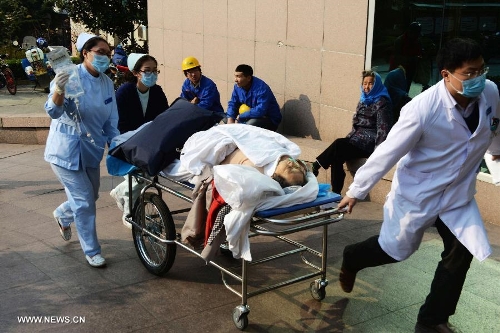Qingdao oil pipeline blast kills 35

An injured receives treatment at the No.1 People's Hospital of Qingdao Development Zone, in Qingdao, East China's Shandong Province, November 22, 2013. A fire broke out and the blast occurred around 10 am in the Huangdao District when workers were repairing a petroleum pipeline which broke and resulted in an oil leakage around 3 am. (Xinhua)
Click to see more photos
Related report: Xi urges on search for blast survivors
At least 35 people were killed and 166 others injured after a leaking pipeline caught fire and exploded on Friday morning in the coastal city of Qingdao in east China's Shandong Province, local authorities said.
Among the 166 injured, 65 are in serious conditions, according to a comment posted on Friday night on the official microblog of the Qingdao municipal health bureau on Sina Weibo, China's Twitter-like microblogging service.
The accident happened around 10:30 am at the crossing between Haihe Road and Zhaitangdao Road in Huangdao District as workers were repairing a petroleum pipeline, according to the Qingdao government's publicity office. The pipeline had begun leaking oil at around 3 am at the crossing between Qinghuangdao Road and Zhaitangdao Road, the office said.
Oil leaked from the Sinopec pipeline into the municipal pipe network, which caused the explosion, according to an initial investigation by the rescue headquarters at the scene.
The district government has ruled out a terror attack as the cause, while the State Administration of Work Safety has sent a work team to the scene to guide the rescue efforts.
About 1,000 square meters of road surface was covered in leaked oil at Zhaitangdao Road. Some of the oil had spilled into Jiaozhou Bay through the rainwater pipeline, and about 3,000 square meters of sea water was polluted by oil, said the rescue headquarters.
Fires and explosions also occurred on the polluted sea waters at the entrance to the bay, according to the headquarters.
An oil belt with a width of two to three meters could be seen in waters around the site of the explosion as of 2:40 pm. No new oil leakage from the pipeline had been found, according to a Xinhua reporter at the scene.
Oil flow through the pipeline was shut off at about 3:15 am. The fire has been put out, and barricades have been set up to stop the oil from entering the sea, according to a comment posted on Friday afternoon on the official microblog of the Qingdao municipal environmental protection bureau on Sina Weibo.
Environmental monitoring showed that the concentration of toxic materials in the air was below the national standard. The local government has told citizens to remain calm.
Xinhua reporters saw cracks in the streets, the longest of which was about 1.5 km.
"I have only seen this in disaster films," said a rescuer surnamed Xue, who drove past the streets where the blast happened.
Xue told Xinhua he was astonished by the sight of a bus sandwiched between huge cracks in the street with passengers trapped inside.
"Some cars along the street are turned over, some are covered with concrete slabs, and some others have lost their window glass," he said.
Wang Aihua, a doctor at Huangdao District People's Hospital, said they have received more than 20 patients injured in the accident and are expecting more.
Some residents have evacuated from the area for fear that a second explosion might occur, added Wang.
A staff member from Huangdao District Hospital of Traditional Chinese Medicine told a Xinhua reporter by phone on Friday night that the hospital had received more than 50 patients since the blast, with some of them under emergency treatment.
The male staff member, speaking on condition of anonymity, confirmed that there had been fatalities, but he refused to reveal a number.
Most of the injuries were fractures due to the force of the blast, he said.
More than 800 doctors and nurses from the hospital have participated in the rescue efforts, he added.
The 176-km pipeline is owned by Sinopec, China's largest oil refiner, and links oil depots in Huangdao with Weifang City, home to a few petrochemical plants.
The pipeline, with a total investment of 1.3 billion yuan ($211.8 million), was put into operation this August. It has an annual transportation capacity of 15 million tonnes.
Huangdao District is connected with the city proper by the Qingdao Jiaozhou Bay Bridge.
Xinhua reporters said the exit on the bridge leading to Huangdao has been temporarily closed and only emergency vehicles are allowed to enter. Local traffic authorities have urged drivers to make way for rescue vehicles.